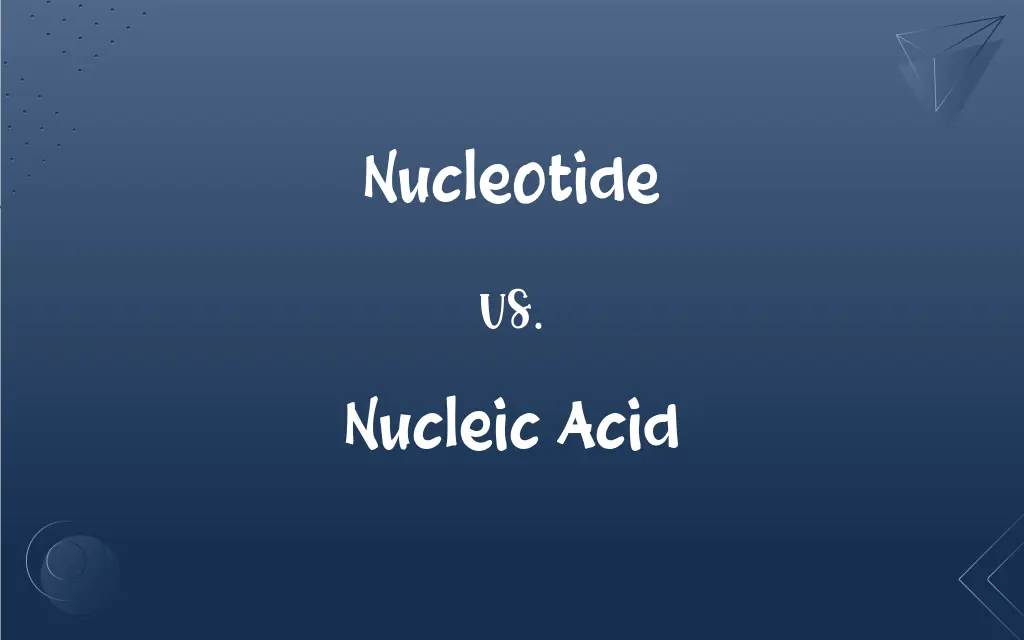Nucleotide vs. Nucleic Acid: What's the Difference?
Edited by Aimie Carlson || By Harlon Moss || Published on January 16, 2024
Nucleotide is a molecular building block of nucleic acids, consisting of a base, sugar, and phosphate group, while nucleic acid is a long chain of nucleotides forming DNA or RNA.

Key Differences
A nucleotide is a basic unit of nucleic acids, comprising three components: a nitrogenous base, a five-carbon sugar, and a phosphate group. Nucleic acids, such as DNA and RNA, are long chains of these nucleotides linked together.
Nucleotides serve various roles, including energy carriers (ATP), signaling molecules (cAMP), and as the monomers of nucleic acids. Nucleic acids function as carriers of genetic information (DNA) and play a role in protein synthesis (RNA).
There are five main types of nitrogenous bases in nucleotides: adenine, thymine, cytosine, guanine, and uracil. In nucleic acids, these bases form the genetic code, with the sequence of bases determining genetic information.
The sugar in a nucleotide can be either ribose (in RNA) or deoxyribose (in DNA). In nucleic acids, this sugar backbone, combined with phosphate groups, forms the structural framework of DNA and RNA.
Nucleotides are linked together by phosphodiester bonds to form the long chains of nucleic acids. The sequence of nucleotides in nucleic acids is critical for genetic expression and inheritance.
ADVERTISEMENT
Comparison Chart
Components
Nitrogenous base, sugar, phosphate group
Long chain of nucleotides
Function
Building blocks, energy carriers
Genetic information storage, protein synthesis
Types of Bases
Adenine, Thymine, Cytosine, Guanine, Uracil
Sequences of these bases form genetic code
Sugar Component
Ribose or Deoxyribose
Sugar-phosphate backbone in structure
Role in Genetics
Monomers of nucleic acids
Carriers of genetic code and expression
ADVERTISEMENT
Nucleotide and Nucleic Acid Definitions
Nucleotide
Composed of a nitrogenous base, sugar, and phosphate.
Each nucleotide in DNA includes one of four nitrogenous bases.
Nucleic Acid
A biomolecule forming the genetic material of organisms.
DNA, a type of nucleic acid, carries genetic instructions for development.
Nucleotide
Acts as a monomer in the structure of nucleic acids.
The sequence of nucleotides in DNA encodes genetic information.
Nucleic Acid
Composed of long chains of nucleotides.
The nucleic acid RNA translates genetic information into proteins.
Nucleotide
A molecular building block of nucleic acids.
ATP, a type of nucleotide, is vital for cellular energy.
Nucleic Acid
Exists primarily as DNA or RNA.
Nucleic acids like RNA are crucial for various cellular functions.
Nucleotide
Plays a role in various biological functions.
CAMP, a nucleotide, is important in cellular signaling processes.
Nucleic Acid
Has a backbone made of sugar and phosphate groups.
The stability of the nucleic acid structure is crucial for DNA replication.
Nucleotide
Can be energy carriers in the form of ATP or GTP.
The nucleotide GTP is essential in protein synthesis.
Nucleic Acid
Carries genetic information in cells.
The sequence of nucleic acids in DNA determines hereditary traits.
Nucleotide
Any of a group of compounds consisting of a nucleoside combined with a phosphate group and constituting the units that make up DNA and RNA molecules.
Nucleotide
(biochemistry) The monomer constituting DNA or RNA biopolymer molecules. Each nucleotide consists of a nitrogenous heterocyclic base (or nucleobase), which can be either a double-ringed purine or a single-ringed pyrimidine; a five-carbon pentose sugar (deoxyribose in DNA or ribose in RNA); and a phosphate group.
Nucleotide
A phosphate ester of a nucleoside; one of the monomeric components of DNA or RNA.
Nucleotide
A phosphoric ester of a nucleoside; the basic structural unit of nucleic acids (DNA or RNA)
FAQs
How many types of nucleotides are there in DNA?
Four types, each with a different nitrogenous base.
Can nucleotides function independently?
Yes, in roles like energy transfer and signaling.
What is a nucleotide?
A molecule consisting of a nitrogenous base, sugar, and phosphate group.
Are nucleic acids found in all living organisms?
Yes, in the form of DNA and RNA.
What is the role of nucleotides in cells?
They are building blocks of nucleic acids and function as energy carriers.
What is a nucleic acid?
A large biomolecule essential for storing and transmitting genetic information.
What is the difference between DNA and RNA?
DNA is double-stranded and stores genetic information, while RNA is single-stranded and involved in protein synthesis.
Do nucleic acids have a role in heredity?
Yes, DNA carries genetic information passed from parents to offspring.
Are nucleic acids involved in diseases?
Yes, mutations in nucleic acids can lead to various genetic disorders.
Are nucleotides only found in DNA?
No, they are also in RNA and other cellular molecules like ATP.
Is RNA a type of nucleic acid?
Yes, RNA is a nucleic acid involved in protein synthesis and other cellular functions.
Can nucleotides repair DNA?
Nucleotides are used in the repair and replication of DNA.
Can nucleic acids be used in biotechnology?
Yes, they are fundamental in genetic engineering and biotechnological applications.
How do nucleotides and nucleic acids interact with proteins?
They interact to regulate genetic expression and cellular functions.
How are nucleic acids formed?
By linking nucleotides together in a specific sequence.
Can nucleotides be synthesized artificially?
Yes, they can be synthesized for research and therapeutic purposes.
How are nucleic acids extracted for genetic testing?
Through various biochemical techniques that isolate DNA or RNA from cells.
How does the structure of a nucleotide affect its function?
Its structure determines its role in energy transfer, signaling, or as a nucleic acid monomer.
Do nucleotides have a role in metabolism?
Yes, especially in energy metabolism and cellular signaling.
Are nucleotides the same in all organisms?
The basic structure is the same, but the sequence of nucleotides varies.
About Author
Written by
Harlon MossHarlon is a seasoned quality moderator and accomplished content writer for Difference Wiki. An alumnus of the prestigious University of California, he earned his degree in Computer Science. Leveraging his academic background, Harlon brings a meticulous and informed perspective to his work, ensuring content accuracy and excellence.
Edited by
Aimie CarlsonAimie Carlson, holding a master's degree in English literature, is a fervent English language enthusiast. She lends her writing talents to Difference Wiki, a prominent website that specializes in comparisons, offering readers insightful analyses that both captivate and inform.































































